
In my opinion I'm very good at this - but that's only my opinion! Here I am swinging at Sidmouth FolkWeek 2015 with a woman who may wish to remain anonymous.
The buzz step swing: some notes on swinging in folk dances - and how to teach dancers to swing!
First published September 2015 - comments welcome.
The key message here is that it is easily possible to remedy the poor standard of swinging that is found amongst so many English folk dancers, especially in small local clubs. Diagrams and photos are included - and comments are welcome.
Please note that diagrams and photos are hurried drafts - they will be improved as comments are collated during 2015.
If you persevere in reading, you'll discover why two young girls caused me to look at their feet. What I saw prompted the creation of these webpages.
|
I am happy at any folk dance or festival event
to spend a few minutes (or longer!) showing dancers how to swing properly. In my opinion I'm very good at this - but that's only my opinion! Here I am swinging at Sidmouth FolkWeek 2015 with a woman who may wish to remain anonymous. |
The notes below are based on my own successful 'remedial' teaching of both adults and youngsters at Gittisham Folk Dance Club, at IVFDF and elsewhere. A few examples are given - it is easily possible to 'retrain' women who have been getting it wrong for years. Brief notes on other types of swinging will be added later. Men are probably as bad - but as yet I've not tried dancing as a woman to confirm this. And I'm not intending to do so any time soon!
Initial feedback has included that I should teach women how to lean slightly back during a swing, and how to 'take their own weight'. These are refinements - I have always found that most problems are owing to incorrect positioning and use of feet. So my teaching centres on getting the feet right. Everything else can follow later.
At International Irish Set Dance weekends it is usual to find that most women can swing beautifully. So why are standards so much lower amongst English folk and ceilidh dancers? Part of the answer (so I have been told by a few Irish Set dancers) goes back to a decision by the EFDSS to abandon strict standards of dance. This happened before I started to dance, so I don't yet know all the history.
There are many 'swinging' steps used in folk dance - that is to say, there are many different ways to swing. Some methods can be selected at will by experienced dance partners. Most 'swinging' in modern ceilidh or contra dance as practised in the UK should use the 'default' or 'buzz step' swing. It is a move that all dancers should seek to perfect - if only because so many dancers (in the UK at least) will expect every swing to be of this type, unless it's a step-hop swing. Several hand and body holds can be used with a buzz step swing. I am concentrating just on the feet - because that is where most of the problems (and remedies) are centred.
More than any other move in folk dances where you interact with lots of other people, swinging can cause the most discomfort (or the most pleasure) depending on how well it is done. In couple dances of course you have to tolerate (or enjoy) one partner for the duration of a dance. In many folk dances you can swing five or ten partners for a few seconds each - and the differences between their abilities can be painfully obvious. If you learn to swing smoothly you'll stand out from the crowd. If done badly and/or too fast, swinging can be dangerous, simply because one or both of you may end up banging the back of your head hard on the floor, or maybe on the edge of a table. This can be fatal.
It is in my view irresponsible of ceilidh and folk dance organisers to mix experienced dancers with complete beginners without warning the beginners that they may be swung fast (unless they ask otherwise) and without offering them a few minutes of instruction before the event. If every ceilidh could start with a five minute 'swinging' session using expert dancers to teach newcomers, some problems might be avoided. Also, fewer newcomers might go away thinking "I can't do that" - never to return.
There are many ways to swing - as this letter from
STS magazine Jan 2015 makes clear. The link given contains a comprehensive explanation of
the buzz step swing.
In STS 90 John Wood said, with reference to a
cross-hand swing at a barn dance, 'A skip around each other is certainly not a swing'. I
beg to differ!. The term 'swing' has been used by dancing masters, callers and teachers
throughout history and across cultures to mean whatever the dancing master wants it to
mean! I have seen it used to mean an open two hand turn, an arm turn and countless
varieties of swing holds and footwork. 'Swing' basically seems to mean 'connect with your
partner and have fun rotating around a shared axis'.
If the dance is a barn dance and the music tells me to, then of course I will skip! If it
is a hornpipe (like Nottingham Swing) then I will definitely be doing a step-hop! The
Quebecois like to place their right feet between their partners feet rather than
toe-to-toe, more like a waltz spin-turn. Buzz-steps (as described by John Wood) are great
fun, but by no means the only way to swing. For more information on buzz-step swings see http://www.contrafusion.co.uk/Contra.html#swinging.
By the way, I run lots of barn dances and never teach a two hand swing. It takes up too
much room and dancers have more of a tendency to lean back. I always teach the dancers to
take a right fore-arm hold, join left fingertips underneath and keep their own balance.
This provides a much safer and more satisfying swing.
Happy dancing John Sweeney
The key elements of a buzz step swing are:
Left feet should always be 'behind' right feet, that is, they should never sweep in front to become the leading feet. Left feet travel around a circle of maybe 300 to 350mm radius - try drawing two concentric circles on the floor using chalk. The inner circle (radius = 120mm) is for right feet. The outer circle (radius maximum 350mm and preferably 300mm) is the track taken by both left feet. Some guidance advocates using a single circle for both feet - not what I do at all!
Many people teach the buzz step by saying the right foot is on a child's scooter and the left foot is always behind, pushing the right foot forward. Again, I've never found that helpful. Some guidance says the right feet should always be firmly down on the floor and with only the left foot ever up on toes. Again, I'd disagree, although as the left foot has a much greater distance to travel it has to be far more 'active'. This can entail being 'on your toes' more with your left foot than with your right foot. Some people say you 'bounce around' on your right foot. That's not helpful either, a smooth swing has no element of bouncing, it is a smooth and often quite fast pure rotation.
|
Here is a diagram from an American
source - and as far as I am concerned half of it is wrong. Taking ballroom hold, bodies should be parallel, not with the woman at 45 degree to the man! If the feet were positioned as shown (which is broadly correct) one or both bodies would have to be markedly twisted. It would be most uncomfortable! This source also says that "dancers' right feet stay close to their centre of gravity". This would be difficult! What the author means is that the centre of gravity of each dancer stays broadly over their right foot! I've added the colour, just to make clear which feet belong to which body. The site does however have lots of useful guidance on other moves. The animation here is correct - dancers turn to face each other , take hold and swing whilst still facing. Click the 'slow' button and press 'play'! |
For fast swinging aim to have your feet travel around as small circles as possible - your right foot should be as close as possible to your partner's right foot, and your left foot should be travelling around as small a radius circle as possible.
Swings should be entirely smooth for both parties. They should never be jerky. Swings in Irish Set Dance are done using the buzz step. Most folk dances seen on the internet are sedate - but not so some Irish Set Dances. An example is given at the bottom of this page of how things can go wrong even for an experienced fast dancer on what is clearly a slippery floor.
If done incorrectly at speed, swinging can be dangerous - and not only because you may trip up or fall over. There is an folk tale of a woman in stiletto heels being swung off her feet at a ceilidh and one of her heels ended up through a man's cheek. All the more reason to learn to swing properly, especially if you aim to do it fast.
A common swing type used in contra dance in the USA is the walk swing - which does involve putting your left foot in front of the right, something you should not do in a buzz step swing. Swinging doesn't work too well if one person in a couple tries to do a buzz step swing and the other a walk step swing. Some of the photos on the next page may illustrate this.
In all swings - keeping both bodies close to the centre of rotation minimises the energy of rotation and enables speed to be built up far faster. Also, if feet are keep broadly underneath bodies, the risks of becoming unbalanced are minimised. There are many examples and tutorials on the internet of how to do a buzz step swing - and some I don't agree with!
Walk step swings are never fast. I regard them as boring. Buzz step swings can be very fast, especially if dancers agree to ignore the music and do steps as fast as they can. In Irish Set Dance a 'house' move can be doubled if the dancers are both competent. An example is linked below. Swinging and doubling are the fastest rotational moves in folk dance, and potentially rather enjoyable.
One of the most common mistakes for dancers in the UK who try to do a buzz step swing is that they have their feet oriented incorrectly - they are broadly on the correct positions on the dance floor but their feet (and usually their bodies too) are markedly rotated relative to their partner. Feet should always have their axis as a tangent to the circle around which they are going - more correctly the front half of feet should be at tangents to the circles - I'll correct the diagrams shortly! The diagrams below show how feet should be oriented in a buzz step swing. Photos of couples swinging in Sidmouth FolkWeek 2015 are now on a separate webpage.
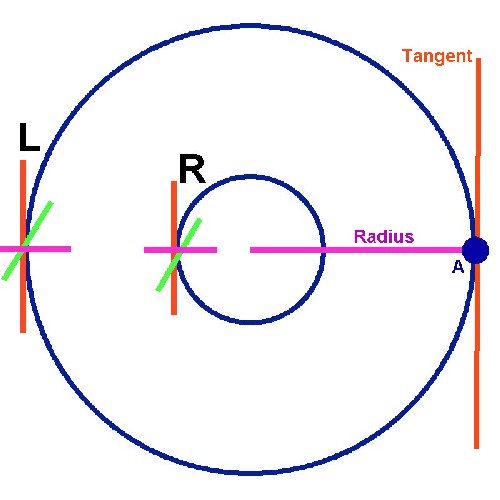 |
This diagram is all that is necessary to
explain what makes many women 'jerky' or uncomfortable swingers. It may apply to men too!
It might make more sense if you study the photos as well. There are two circles, the inner one is for dancers' right feet. Only one dancer's feet are shown, at the left of the diagram. At the start, feet may be aligned as shown, side by side. During a swing the left foot should always be 'behind' the right foot. A radius line may be drawn in any direction from the centre of a circle - one such line is shown drawn to point A. At this point a line at right angles to the radius is called a tangent line (shown red). The absolutely key point to understand is that wherever feet contact a circle (here shown to the left of the diagram) the line of the feet should be at a tangent to the circle at that point. Many women try to swing with their feet oriented on the green lines. Even worse (and only experienced in a few cases) is to have both feet oriented about one of the the purple (radius) lines (see diagram below). This makes a dancer shuffle sideways around a circle! The importance of this is better illustrated by teaching steps in a straight line, before teaching how to progress around tight circles. |
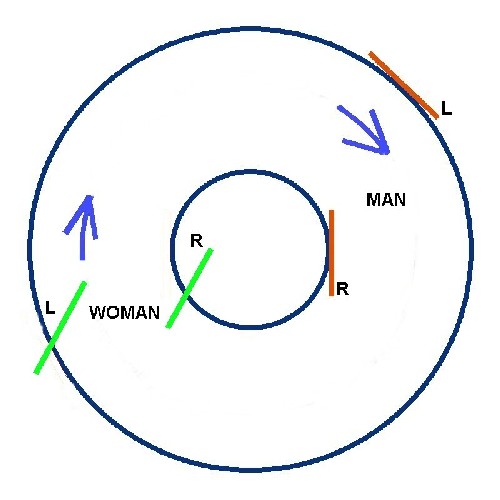 |
This problem is all too common. Whilst the
man's feet are correctly oriented at tangents to the circles (and with the left foot
always trailing behind the right), the woman's feet are twisted inwards at an angle, thus
her toes no longer lead her feet around the circles: there is an element of 'sideways
shuffle'. Simply teaching dancers to reorient their feet onto red (tangential) lines and letting them practice with a competent partner for a few minutes can be all that is necessary to convince them that swinging can indeed be a much smoother experience. However, it can take quite a bit of practice to 'unlearn' the bad habits of a lifetime. A few women are dismissive when offered a free lesson - one response from many years ago comes to mind. The woman's incompetence was matched only by her size. "I've been swinging like this for 15 years and I don't need you to tell me how to do it." Oh yes you do dear! |
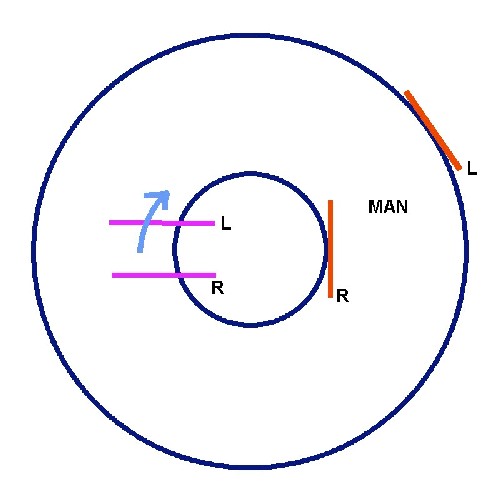 |
This fault is very rare, but I experienced it
twice at the IVFDF event at Exeter in 2015. I danced with two young girls, each about 5' tall. My expectation was that they would both be a dream to dance with. In fact they were amongst the most uncomfortable partners for swinging I had ever experienced. Luckily they were lightweight and easily controlled. This experience caused me to look closely at their feet. Both girls had their feet broadly on radius lines (shown purple) and obviously with their left feet leading. I asked both of them why they were swinging in such a manner, doing a sideways shuffle. Both said that was just how they did it - and they had never been shown otherwise. After a few minutes instruction both were much better and they expressed delight at how much more comfortable it all was. It was this experience that caused me to look more closely at other partners and to come to the conclusion that so many could be improved simply be reorienting their feet. This has proved to be correct. This text is in draft - comments are welcome: Some photos follow if you prefer photos to diagrams! |
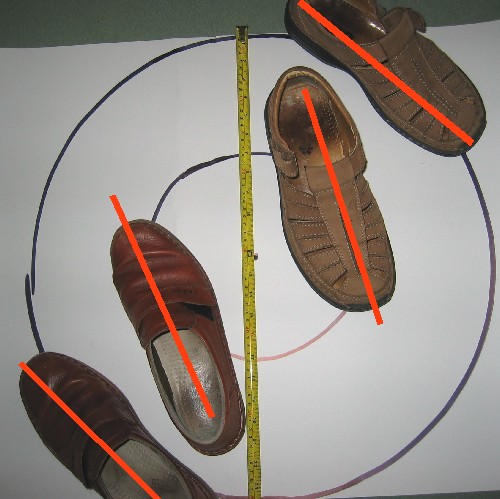 |
This shows my principal 'teaching aid' for
swinging - a piece of very strong plastic coated paper with two concentric circles. The
outer circle has a radius of 290mm (just under one foot!) and the inner circle 130mm. Two
sets of size 9 sandals complete the picture! These feet are positioned in a typical 'correct' position for a buzz step swing. Left feet are trailing behind. Ideally, the right feet would be closer to each other but only expert dancers usually can maintain (or choose to maintain) such close proximity. But for fast swinging, the closer the better so that left feet also may be drawn in towards the axis of rotation. All feet are on tangents to the circles, shown as red lines. The photos of good dancers on the next webpage show this positioning and orientation of feet - give or take a few degrees! |
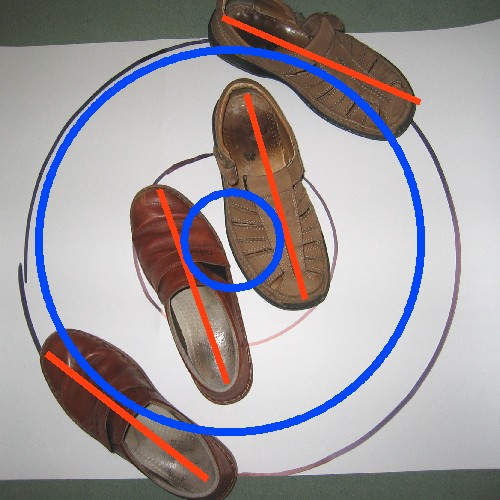 |
This shows a typical position for feet for a
buzz step swing if good dancers choose to be close to each other - so making fast rotation
easier. All feet are on tangents to the blue circles, which have a smaller diameter than
the black circles drawn on the paper. At a recent international Irish Set Dance weekend I danced with maybe 15 highly competent dancers - during the weekend we danced over 30 sets. Many of them were quite complicated and almost all involved some swinging. All these women were superb to swing with - smooth and fast. And (guess what) when I looked at their feet all of them were oriented exactly as is advocated here. |
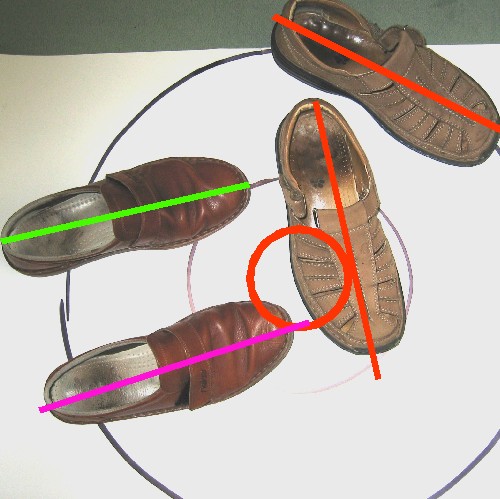 |
This is appalling but quite rare. Whilst the man's feet (to right of picture) are correct (and on red tangent lines), the woman's feet are a mixture of the green and purple lines shown in the diagrams above. Her left foot is leading the rotation (which would be the least of her problems) and her right foot is almost on a radius to the axis of rotation, at right angles to where it should be. |
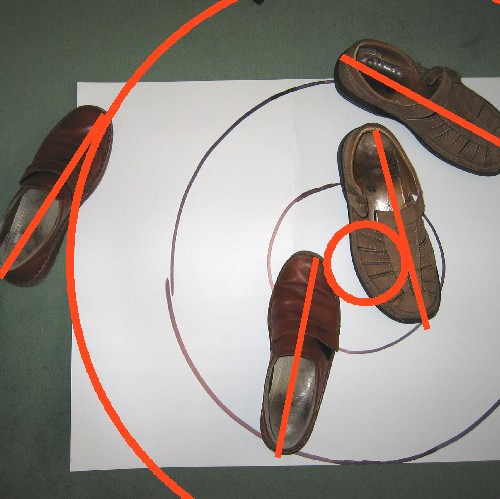 |
In contrast, this is a very common problem. Again the man's feet are shown correctly oriented and positioned. The woman's right foot is as correct as makes little difference but her left foot is far too far out - on a radius of nearly 450mm. This leads to several problems - jerky swinging as her left foot has to take large steps to keep up with the rotation, and the likelihood with a fast partner that her feet may leave the ground completely. And it is her own fault! The golden rules are to keep feet close together and to keep them close to the ground. Finally
- it is so easy to show people how to swing properly. I've done this now dozens of times,
and it works. A few dancers at Gittisham club are now much
improved and more will follow, it is to be hoped. |
folk dance moves - a few webpages detailing various common and not so common moves in folk dancing
folkdanceteach page (general notes on my folk dance lessons as they started at Gittisham Folk Dance Club)
folkdanceteachswing2 page (photos of good and bad positioning of feet during a buzz step swing)
Gittisham folk dance club page
top page for folk dance clubs - a section of the SeeRed website including notes on some folk dance venues in Devon